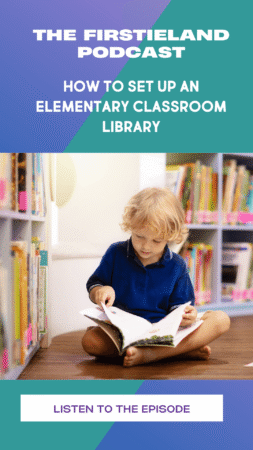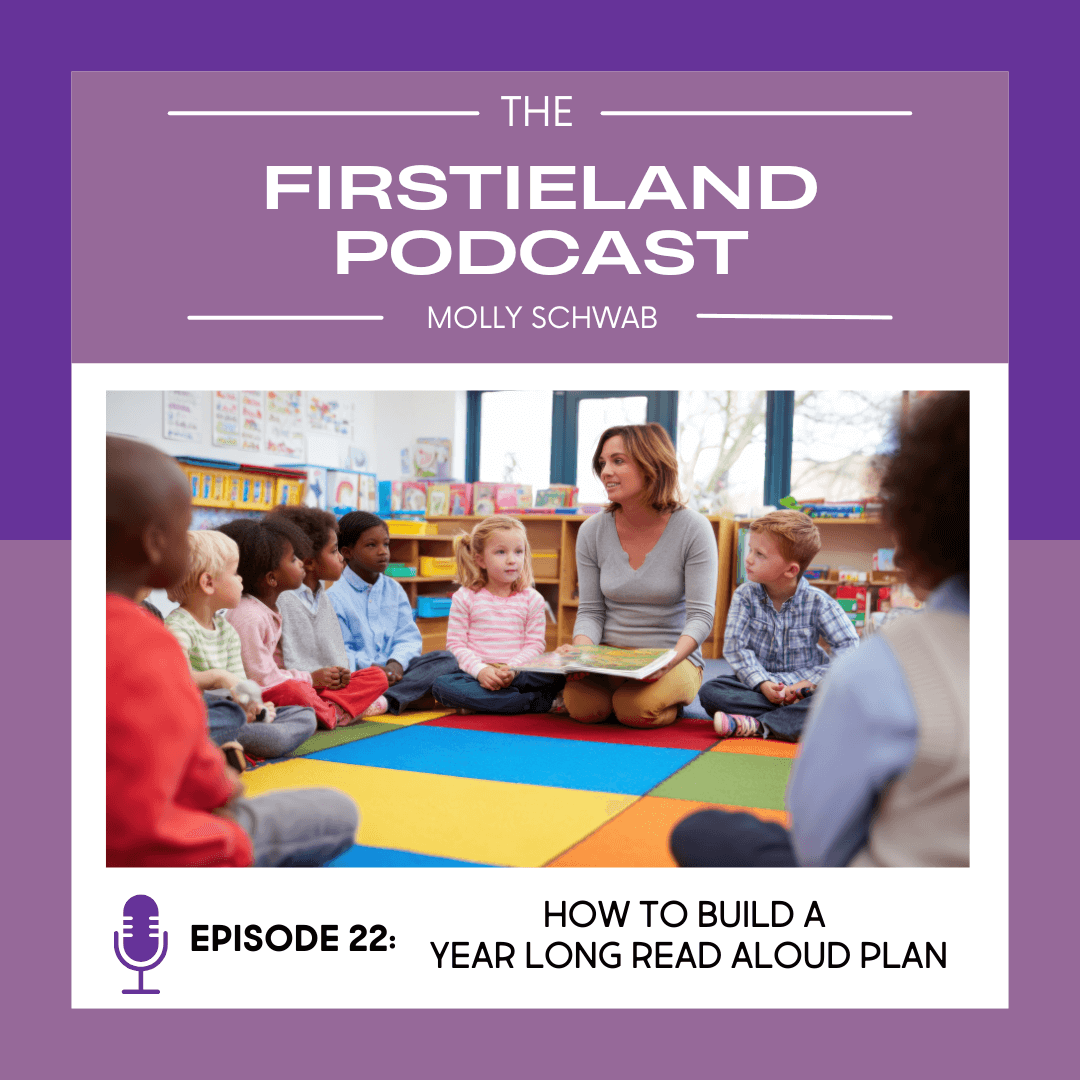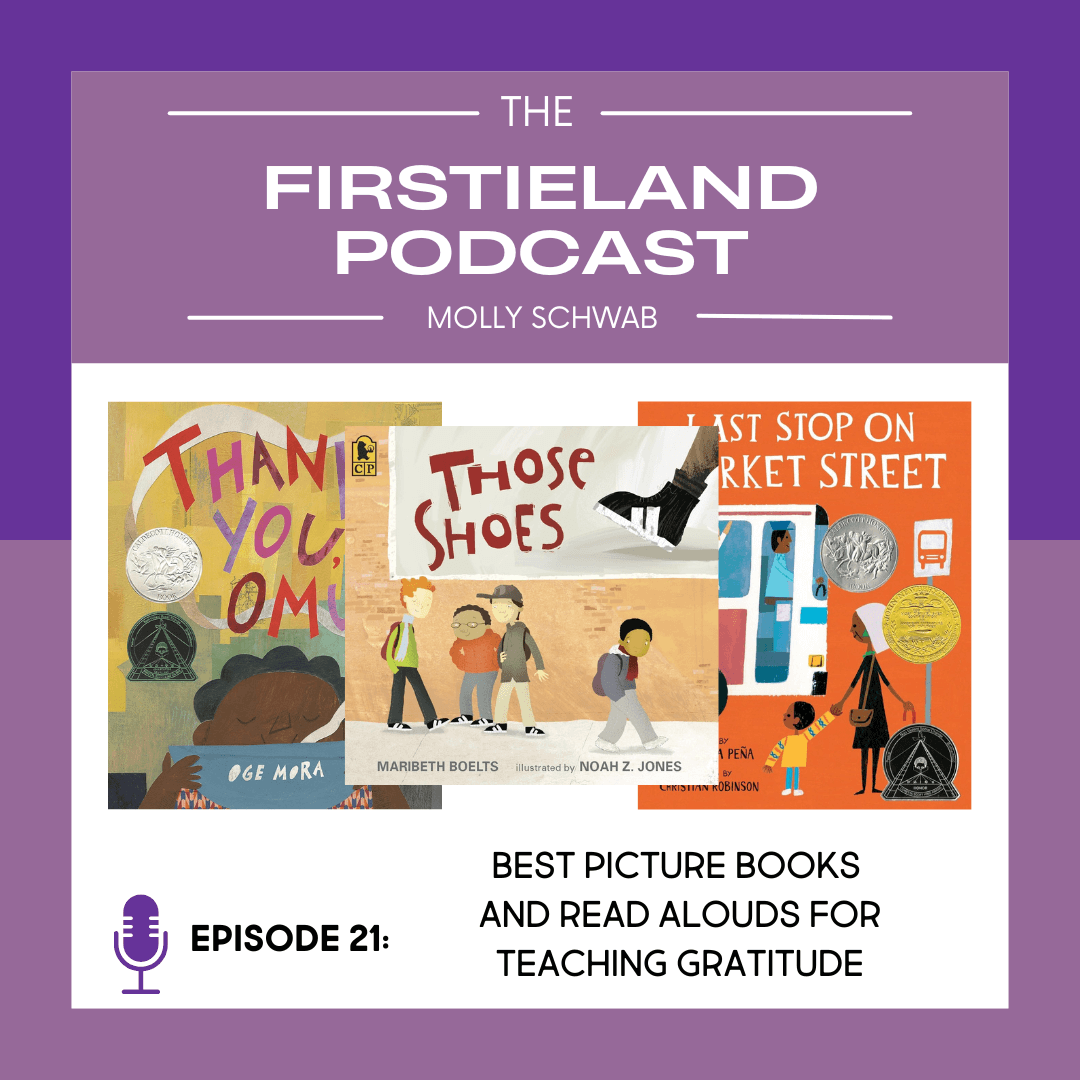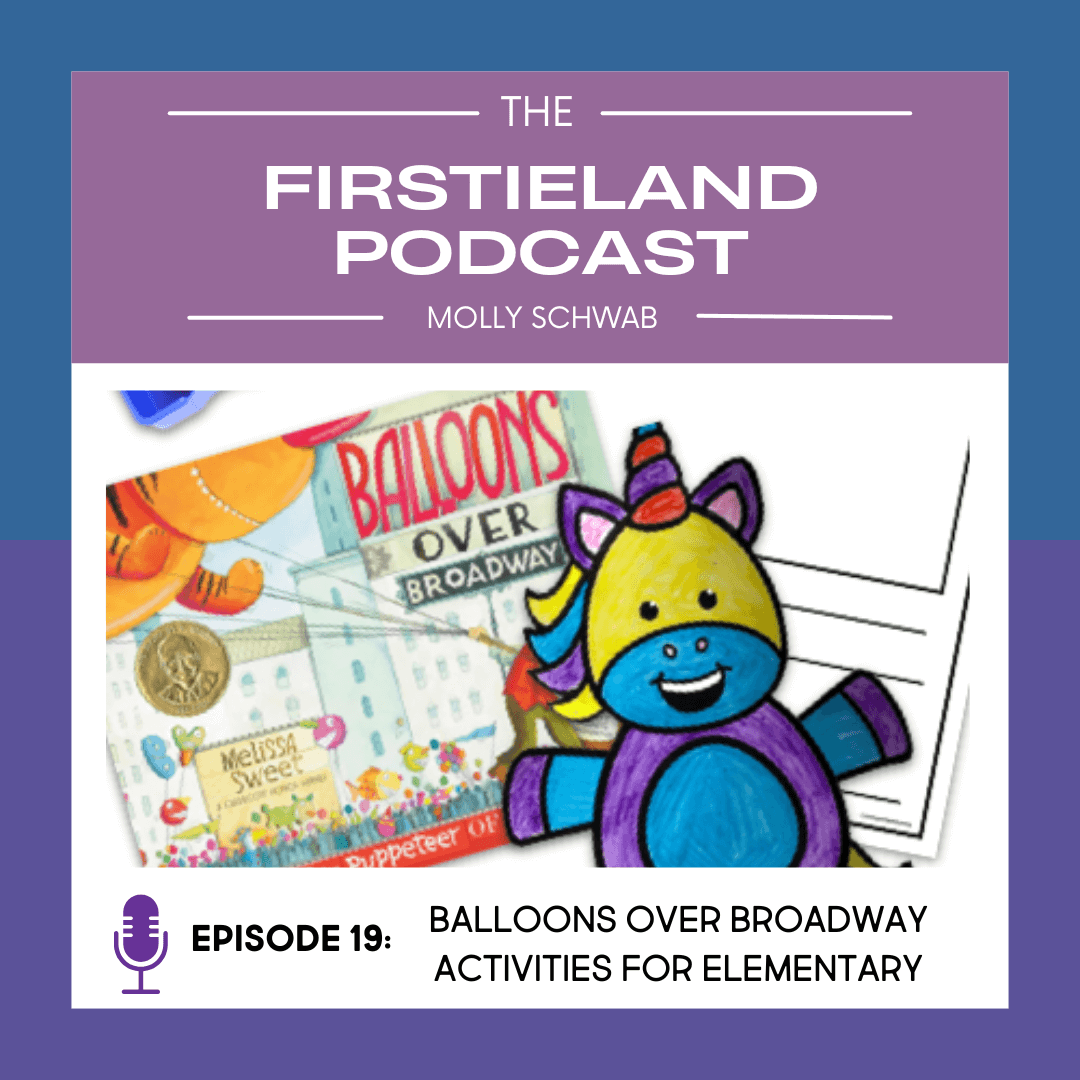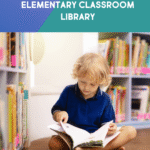[00:01:00]
Okay, so to get started, I think that every kindergarten or first grade needs a classroom library. First of all, it’s the place where all of your picture books can be stored. It can also be a gathering place to read stories. You know, in the past I always tried to make my library the center of my classroom.
I really wanted to convey the message that reading was the most important thing that we were gonna learn all year. And by making our library the. Focal point. I could show the kids that, in a real literal sense, several years. I literally put my classroom library in the center of the room and everything else, like the kids’ tables and the centers, they were all around the library and I really liked that setup a lot.
Other times I put my library [00:02:00] around my large classroom carpet where we would gather for morning meetings and other lessons. I liked that too because we could just reach for any book that we needed right at that moment. And then other times my library was a separate space in the corner of the room.
Really, whatever way you choose to do it, I do think that it’s important to have a classroom library of some sort in your room. This is where kids are gonna come to relax. They’re gonna browse through books, they’re gonna learn about different genres of literature, and they’re really gonna come to love some of their favorite authors in your classroom library.
So this place is really gonna help your students grow to love books and reading. Alright, so let’s start at the very beginning of creating a classroom library, which are the books that you choose. You’re gonna want a variety of genres, favorite authors, and all different levels of books so that all of your kids can find books that interest them.
We all know that books can be [00:03:00] expensive, but there’s a few ways that you can start to fill your library on a budget. I think Scholastic Books is a really great place to start. You can send home the monthly scholastic book club flyer, , with your students, and then parents can buy books for their kids at home.
And when they do that, you are going to earn bonus points and then you can save your bonus points until you have enough to get free books or. You can buy single books or you can buy book sets. You can even get books and CDs for your listening center. I don’t know, do they still have CDs?
I’m not really sure. They still had ’em a few years ago, but I’m not really sure. Now, another really great place to get books inexpensive is garage sales and thrift stores. You can get great books for like a quarter a piece, and summer is the time to get out there and hunt for those bargains. So if you’re listening during the summertime to this episode.
Check it out and get to your garage sales. They usually start on Thursday or Friday, so check your local Facebook group or your newspaper and then make a list of the [00:04:00] sales that you wanna visit and get out there early with a pocket full of quarters, and you’re gonna be amazed at how many great books you can find, and it’s way cheaper than buying them brand new.
All right. My next tip is to just ask for donations. Honestly. Send a letter home to parents or even make a Facebook post. A lot of times people have kids’ books laying around after their children grew up and they’d love to donate them to your classroom. People really like to know that they can help kids and put those books to good use in your classroom.
So just ask. Another great idea is to create a Donors Choose Project. If you’ve never heard of it, donors Choose is an online organization that allows teachers to make projects that they would like funded for their classroom. I. People from all over the world can donate to help fund your request. And if you post it on your Instagram or your Facebook page, sometimes friends and family will make donations to, it’s totally free for teachers and it’s a great way to get books and other materials for your [00:05:00] classroom.
And then finally, if you aren’t able to purchase books or get them donated, you can always just borrow books from your school or your local public library. You can usually borrow up to 10 or 20 books at a time, and you could display them in your classroom library for kids to enjoy. All you have to do is check out the books, enjoy them for a while in your classroom, and then after a couple of weeks, return them to the library and get more.
That way you can always have a fresh batch of books for kids to look at, , and you’re always rotating them. They never get bored, and you literally don’t have to spend one dime of your own money for books. All right, once you have some books, you’re gonna need a space for your library. If you have enough room, it’s a nice idea to get some kind of floor covering a small carpet or maybe some foam squares for kids to sit on.
And if you don’t have space for another carpeted area in your room, you can always use my suggestion that I mentioned at the beginning of the podcast and have your main carpet area double as your classroom [00:06:00] library. You’re probably gonna need a few pieces of furniture, maybe one or two low shelving units to organize your books to start.
Now, if your school doesn’t provide shelving and you can’t afford to purchase your own, you can always just lay your book tubs around the carpet on the floor. I mean, it’s not ideal, but hey, you have to start somewhere. And before you go crazy buying a bunch of stuff, go down into your own basement or attic and look around.
Maybe you have some old shelf that you could use or check. Facebook Marketplace, you can always find stuff cheap. And then finally, it’s really nice to have some kind of cozy seating, maybe a beanbag chair, an old comfy chair from your house, or even a little rocking chair.
Soft lighting makes your library feel cozy too. So while you’re looking for books at garage sales. Scope it out and see if you spot any cute little lamps. And remember if you find something you like, but it’s the wrong color, or you know it’s leopard print or something crazy that you don’t want, paint is [00:07:00] your friend.
You can paint just about anything, whatever you do, don’t go out and spend hundreds of dollars on this. You can definitely find used furniture for your library and you can make it look really cute with paint. I always used spray paint to paint my classroom furniture. You wanna get rustoleum satin finish paint.
I think it looks the nicest when you’re done. Just make sure that you use several very light coats when you’re painting. If you put it on too thick or fast, it’s gonna run, so take your time and it’s gonna look great. All right, so now you’ve got your books and you’ve got your space for your library. So the next step is getting it organized.
The first thing you wanna do is separate your books into different categories, and there’s lots of different ways you can do this. You can separate by genre favorite authors, holiday, seasonal. You could separate by leveled books, nonfiction. I mean, those are just a few of the choices you have to make your own decision on how you wanna do that.
If you have enough books, you can choose all of those [00:08:00] or just a few. So decide how you wanna separate your books and put them in piles. Then you’re gonna need to label your books and designate which category they’re gonna go into. I made a free set of labels that you can use for this, and I’ll put those in the show notes for you.
When I first started labeling my books, I made the mistake of putting the labels on the front cover of the books, which was a mistake. I guess I thought that if kids couldn’t see the label easily, they wouldn’t put it back in the right spot.
But looking back, I really wish I would’ve put the labels on the inside front cover anyway. I had labels for all different authors, different genres, nonfiction, everything you can think of. . You could also use colored sticker dots to label your books. I’ve done that in the past too. Whatever you choose, it’s a good idea to label your books in some way because it gives your kids a simple visual clue to show where each book belongs in your library.
- Alright, so we’ve got your books, your space, your furniture, and your books are labeled into different categories, so now it’s [00:09:00] time to organize them in some way. My best advice is to get some kind of book bins to put them in. I really don’t recommend putting them on the shelves like you would see in a public library because it’s too hard for young kids to put them back on the shelf in an organized way.
And honestly, you’re gonna just have a jumbled mess. You can actually find really inexpensive, colorful plastic boxes at your local dollar tree that are perfect to use in your classroom library. That’s where I bought all of my book bins and they lasted for years. You can get clear boxes or colored ones.
Just be careful what color you choose because you’re gonna be stuck with it for a long time. I bought. Lime green boxes. And since I didn’t wanna keep replacing them, when I changed out the colors or the theme in my classroom, I had to work around lime green, which was tough. Luckily I liked the color and it worked for me.
But just keep that in mind when you’re choosing a color, you wanna choose a bin that’s big enough to hold all size books, including your larger books too. So think about that when picking out your [00:10:00] book boxes. A lot of teachers like to color coordinate their library bins with their classroom colors or theme because it really does give a nice, neat look to your classroom.
If you choose to do this, you can add coordinating labels to the front of each book bin that matches the labels on your books. And actually, that can really help with your library organization because kids can match the label on the book to the label on the bin.
Okay, so now you have your library all set up, so you’re gonna need to establish some rules. You never wanna set kids loose in your library without going over all the procedures first. Otherwise you’re gonna have a mess.
And the last thing you want, after all your hard work is for your books to get destroyed or just so mixed up that you can’t find anything. . You can create your library rules with your class, which is always a good idea.
I think that whenever you create any kind of classroom rule, kids will be more invested in it and are more likely to follow the rule if they’re part of making the rules. So some library rules that you might wanna consider [00:11:00] are things like, only take one book at a time from the book bin. Keep all the books facing forward in the bin.
All the books should be returned to the same bin that you took it from. Handle the books with care, and if you find a damaged book, put it in the book hospital. In my classroom, I had a box that I labeled the book hospital. Anytime a student came across a damaged book that could put it in the book hospital, which you definitely want to do because guaranteed, whenever a kid finds a book with a little tear or whatever, they’re gonna need to point it out to you immediately.
So if you make a book hospital, it’ll eliminate kids interrupting you a small group, or when you’re in the middle of teaching, they can just put the damaged book in the book hospital, and then maybe once a week have a designated student bring all the damaged books to your desk and you can fix them and put them back into circulation.
All right, let’s recap. You have your books, your space, your books are all labeled in your library, and you [00:12:00] created your rules with your class. So your final step is to create some kind of checkout system In my classroom, each of my kids had a book box that they could read from During our quiet reading time, they could choose books from our leveled books or our picture books.
So we needed a checkout system for that. Some teachers want kids to be able to take books home to read as well. So if you’re gonna have anything like that, you’re gonna need to create some kind of classroom library checkout system because you want your books to stay clean and neat and be returned in the correct manner.
So one way of doing this is to put a library pocket in the back of each book. You can write the name of the book on an index card, and then you put the card in the pocket. Then when kids wanna check out a book, they can take the card out of the pocket. Write their name on it, and then put it in a little basket that you keep at the library.
Or another way to use library pockets is to make a bulletin board at your library where each child has their own library pocket hanging on [00:13:00] the board, and then when they wanna check a book out, they can just take the card out of the book and place it in their own pocket on the bulletin board. It’s a really simple system and it makes it easy to see.
Who has which book? With a glance at the bulletin board. If you wanted to, you could create a class job and have somebody be the librarian. They could help. Keep the library neat. Make sure the books are put back in the right box and make sure kids check out books correctly. I.
Okay, so now that your library is set up and ready to go, you wanna make sure that your kids are interested and excited to use it. The last thing you want is to just never change anything at your library because then it comes a boring, stale place where nobody wants to go. So. The first thing you need to do is make it inviting.
You want it to be a cozy place that kids want to visit. Have a little comfy chair or a beanbag, maybe even a small couch where kids can cozy up with a book. You could have a basket of beanie babies or small stuffed animals that kids can read to and [00:14:00] maybe even add some soft lighting or twinkle lights that gives your library like a really charming little feel.
Another way to make it inviting is to rotate your books. Some of the books in your library are gonna stay there all year, like your leveled books, but other books can be rotated in and out of your library to keep kids interested. You could bring out your holiday books at the beginning of each month and put them in a special box to make it interesting.
In October, as an example, I always put my Halloween books in a big. Cauldron and then I added some witches fingers as pointers and the kids that loved that, and of course they wanted to go and look at the Halloween books. Another idea is to have a monthly author showcase. You can have a special bulletin board with the author’s picture and some of his or her books, and then you could read a few of those books to the class to spark some interest in that author and then display their books for that month, , on a special shelf or something.
Another way to keep your classroom library fresh and inviting is to add some fun props. [00:15:00] I always had cute pointers at my library, and I buy different holiday glasses from Dollar Tree, and I pop the lenses out of them, and then I put those out every month at the library.
I had ones that looked like heart shaped at Valentine’s Day and Shamrock Shape at St. Patrick’s Day. And then I told the kids that they were magic reading glasses that would help them read, and they loved that. So there you have it. Just to recap, you wanna start at the very beginning by gathering your books.
Find ways to get them cheap or free if possible. Then make a cozy space somewhere in your classroom and add some soft lighting or comfy chairs. Then get your book boxes. Organize all your books by genre or season or whatever you choose. Make a book hospital for damaged books and then create some rules so kids know exactly what’s expected of them, and then make sure you have a checkout system to keep it organized and neat, and make sure that you keep kids interested and wanting to go to your [00:16:00] library by adding some fun props or author studies.
Alright, friends, thanks so much for joining me today. I hope this episode gave you some simple, practical ideas to help you set up a cozy and organized classroom library that your kids are gonna love. Remember, you don’t have to do it all at once. Just start small and build it out over time. And before you go, be sure to grab your free classroom library book labels.
They’re linked in the show notes and they’re gonna make organizing your library so much easier. All right, see you next time.
[00:17:00]
